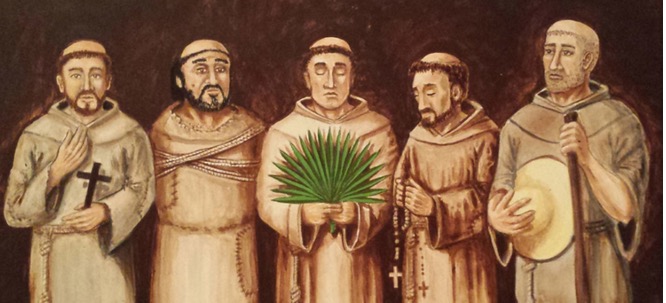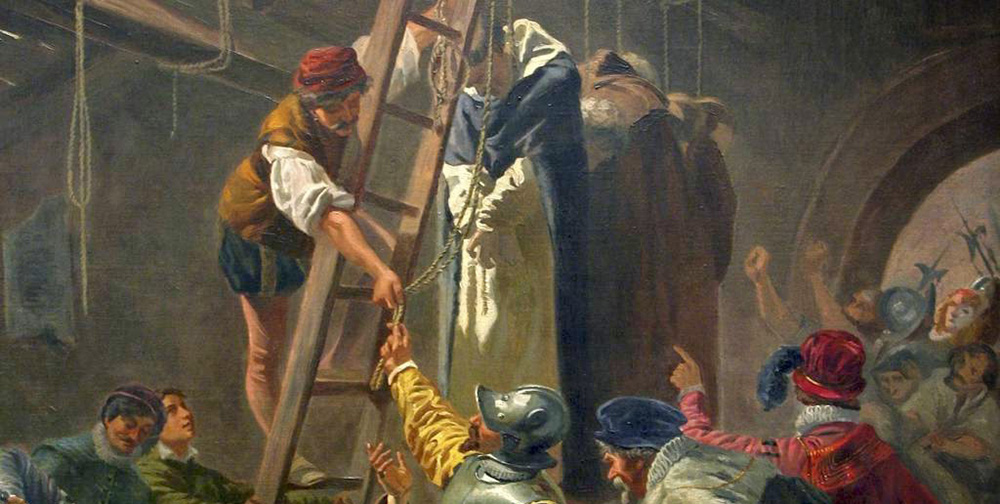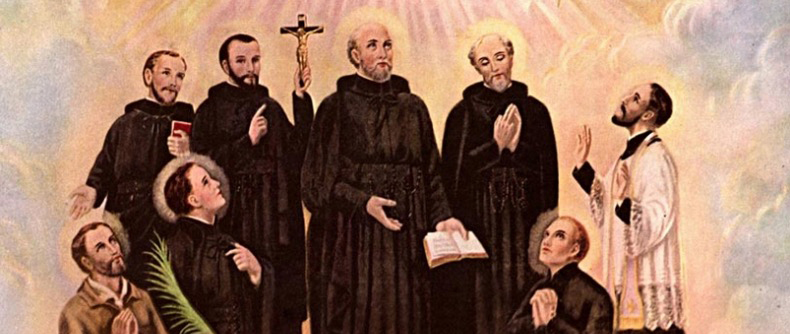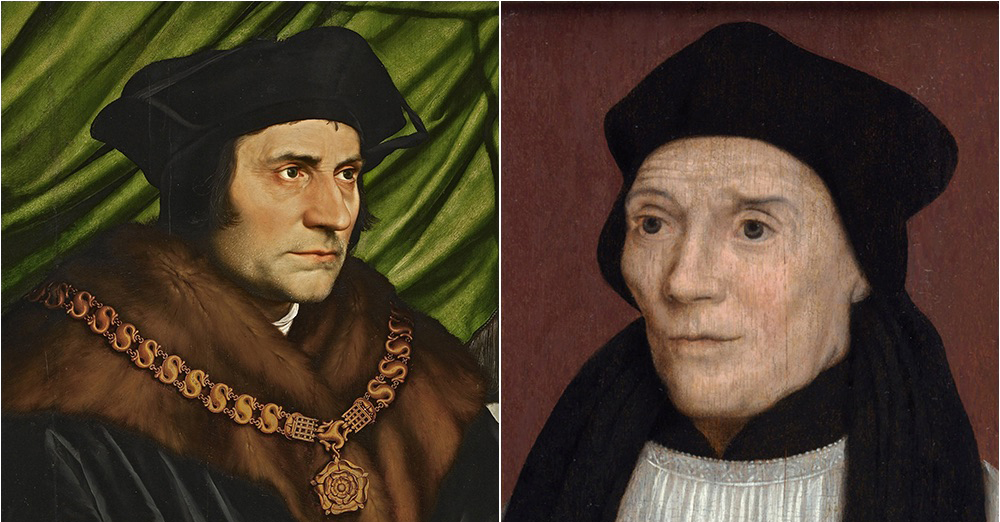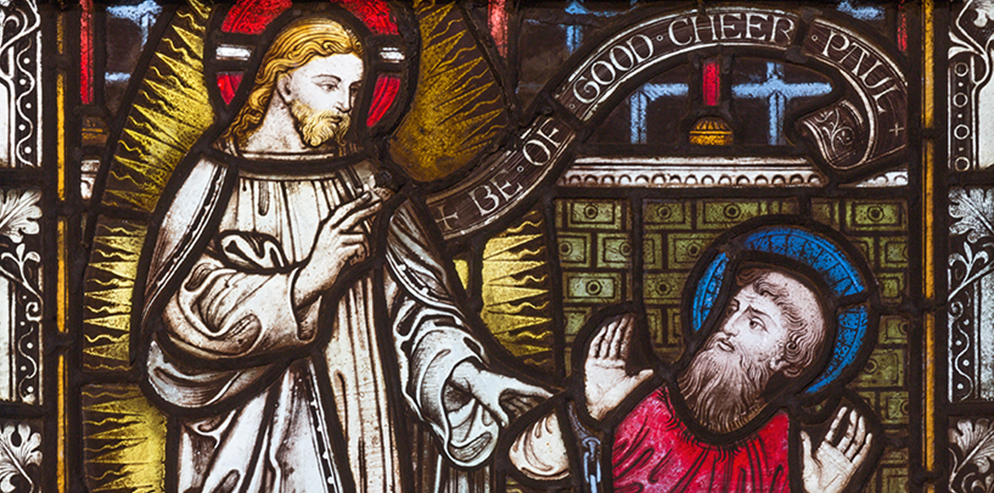“It is the pious belief that these blessed ones are in God’s presence, interceding for the conversion of this land.” So wrote the Franciscan friars working in Spanish Florida on Oct. 16, 1612, to King Philip III of Spain.
It was then the 15th anniversary of the death of five friar missionaries who had lost their lives preaching the Gospel on the northern coast of Spanish Florida (which included part of present-day Georgia), just south of today’s city of Savannah. Although they are known as the “Georgia Martyrs,” the Church has never pronounced on the genuineness of their martyrdom. If it does, the list of American saints and blesseds will be expanded by five.
Profiles of the Men
Who are these men? All five were Spanish Franciscan friars who volunteered to work for the evangelization of the native people of Florida. In the 16th century, Spain had seen a great outpouring of the Holy Spirit expressing itself in a new zeal for living the Gospel and proclaiming its message of God’s love to the New World.
St. Francis, in his Rule of Life, had long before challenged the friars “who by divine inspiration desire to go among the Saracens [Muslims] and other nonbelievers.” He quoted to them the words of Jesus: “Whoever loses his life for my sake will save it” (Lk 9:24). Five men who accepted that challenge came to the Georgia missions, a particularly dangerous assignment in the territory of the already restless nation of the Guale (a Native American tribe).
Pedro and Antonio
The first were Pedro de Corpa and Antonio de Bádajoz, who arrived together in 1587 and worked 10 years in the missions before their death. Both Franciscans, they were unlike in several ways.
Pedro came from a little village near Madrid in central Spain, and Antonio was from Extremadura, a region of southwestern Spain on the Portuguese border. Pedro belonged to a regular Franciscan province, while Antonio be-longed to a special province, said to be “of the strictest observance.”
Pedro was a friar priest, preacher and confessor, while Antonio was a lay friar. To facilitate his work as a missionary, the friar priests had given Antonio a crash course on evangelization, shaved his head with the clerical tonsure and called him “Padre,” all to make him no less than they in the eyes of the Guale.
Pedro was assigned to the mission at the Guale village of Tolomato, near modern Darien, Ga., an important post because in its council chamber hung the royal coat of arms, the symbol of Spanish authority.
Antonio, with 10 years’ experience among the Guale by 1597, and fluent in their language, was assigned to assist the newly arrived Father Miguel de Añon at the mission on St. Catherine’s Island.
Blas, Miguel and Francisco
Belonging to the same strict community as Antonio was Blas Rodríguez. He had been raised in the village of Cuacos, close by the great monastery of Yuste, where Emperor Charles V was living in retirement. Blas, a priest, came to Florida in 1590 and was stationed at the mission in Tupiquí, somewhere near modern Eulonia, Ga.
The latest arrivals, in 1597, were the priests Miguel de Añon and Francisco de Veráscola. An air of mystery surrounds Miguel. He seems to have been of noble origin, although the place of his birth has not been discovered, and he seems to have exercised some responsible role in Spain that left him with the title “Commissary.”
He almost missed his calling in Florida. On his arrival he was called to Havana to preach. Becalmed off Cape Canaveral with time to reflect, he had a sense that the Lord had a mission for him in Florida, and he returned to join Antonio on St. Catherine’s Island.
Concerning Francisco, more is known since the Basque have done much to preserve his memory. Born Feb. 13, 1564, at Gordejuela in the Basque country, Francisco joined the Can-tabrian Franciscan province, volunteered for Florida, and arrived in 1595.
The location of the mission where he died two years later, long held to have been on Georgia’s St. Simons Island, has been identified more recently as the mission excavated at the Fort King George State Historical Site, near Darien.
Why Were They Killed?
The courageous defense of truth by the Georgia “Martyrs” makes them witnesses for 21st-century America. They died for the sanctity of marriage. The catalyst for their death was their refusal to allow a baptized Catholic to take a second wife.
It was the practice of the friars to explain Christ’s teaching on the unity and indissolubility of marriage to candidates for baptism. Thus when a young convert named Juanillo, a candidate for the role of chief among the Guales, made clear his intention to take a second wife, Fray Pedro exhorted him not to do so, saying that if he persisted, the friars could not lend their support to his desire to be chief.
Juanillo left the mission to return under cover of darkness with a band of pagan Guale from the interior. Pedro was bludgeoned to death as he left his hut to offer Mass on Sunday morning, Sept. 14, the feast of the Exaltation of the Holy Cross. His severed head was impaled at the mission landing.
The rebellious Guale now decided to dispatch similarly all the “troublesome friars,” as they called them, who interfered with their having many wives.
Blas died at Tupiqui on Sept. 16 after telling his captors he was not afraid to die, but he grieved that they were unmindful of what the missionaries had taught them about the way to happiness and to eternal life. Miguel and Antonio died the next day, Sept. 17, the feast of the Stigmata of St. Francis. The local chief had tried to induce them to flee to safety to San Pedro (Cumberland) Island, but they refused, celebrated Mass and awaited their death.
Finally, Francisco, arriving back from St. Augustine with gifts for his people, oblivious to the rebellion, was taken by surprise and slain as the others had been.
The “Martyrs” of Georgia are martyrs for the sanctity of marriage. This is exactly what the friars declared to the king in 1612:
“In the early days we experienced great hardships along with threats of death. On various occasions they tried to kill us – as indeed in the Province of Guale they did slay five friars and capture others. Though they did not kill them because of doctrine, it is certain that they slew them because of the Law of God which we were teaching them and because of our moral precepts. . . .
“Specifically they slew them because we would not consent that any married Christian should have more than one wife. It was for that very reason, and no other, that John the Baptist was beheaded – for he had reproved Herod for that very same thing.”
A Witness Much Needed Today
The “Martyrs” of Georgia bore heroic witness to the sacredness of marriage, that sacredness taught by Jesus the Lord, declared by the Second Vatican Council, defended by Pope Paul VI, and explained by Pope John Paul II. The latter called for heroic witness to the splendor of truth:
“Fidelity to God’s holy law, witnessed to by death, is a solemn proclamation and missionary commitment usque ad sanguinem (unto the shedding of blood), so that the splendor of moral truth may be undimmed in the behavior and thinking of individuals and society”(Veritatis Splendor, no. 93).
But why the recognition? Canonizing martyrs does not increase their happiness, but the recognition of their witness to the faith moves us to imitate their courage. No one would deny that we need such a witness.
We also need their intercession. Remember the words of the friars in 1612: “It is the pious belief that these blessed ones are in God’s presence, interceding for the conversion of this land.”
The land is still here, stretching from sea to sea, filled with peoples from many nations, and always in need of conversion.
Father Conrad L. Harkins, O.F.M., is vice postulator for the cause of the Servants of God Pedro de Corpa and companions.

